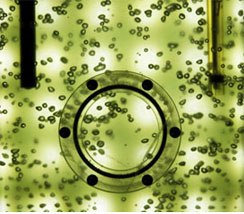February 2011
Synthetic Biology at the Science Museum
16/02/11 09:16

What is ‘synthetic biology’ and how could it solve some of the challenges we and our planet face? Paul Freemont and Richard Kitney will get you up to speed on the science of making life.
Can we create life to mop up pollution and even make fuels? Susan Rosser joins us to talk about what’s going on right now to help us clean up our act and tackle climate change.
What happens when lively young minds are free to invent life? Jim Haseloff and his students discuss some of the thoughts generated at IGEM - an annual competition of synthetic biology ideas for the future.
Claire Marris shares her thoughts on the social and ethical dimensions and how synthetic biologists think about life, the world and the potential of their work.
Speakers:
Paul Freemont, Co-Director, and Claire Marris, Senior Research Fellow, EPSRC Centre for Synthetic Biology and Innovation, Imperial College
Richard Kitney, Head, Department of Biological and Medical Systems, Imperial College
Susan Rosser, University of Glasgow
Jim Haseloff, University of Cambridge
Facilitator:
Mun Keat Looi, science writer, Wellcome Trust
Event organised by: The Science Museum
http://www.danacentre.org.uk/
E. chromi: Design of the Year 2011 nominee
15/02/11 09:09
E Chromi at the Design Museum, London
"Our collaboration meant that from the start E chromi was a project that was designed from the start from a human scale"
One of the nominees for Brit Insurance Design Awards 2011 is E chromi, a project in which designers Alexandra Daisy Ginsberg & James King worked alongside students and faculty at Cambridge University. Preparing for the International Genetically Engineered Machines competition (iGEM), the students had created E.Coli bacteria which produced pigments under certain conditions. Ginsberg and King helped them to imagine the implications of their work in the lab, turning some of their research into design proposals, and branding the research project as E chromi.
"Our collaboration meant that from the start E chromi was a project that was designed from the start from a genetic and a human scale," explains James King. "And with a longterm outlook."
(from http://www.londondesignfestival.com/blog/e-chromi-embedding-design-scientific-research)
http://www.echromi.com/

E. chromi from Alexandra Daisy Ginsberg on Vimeo.
"Our collaboration meant that from the start E chromi was a project that was designed from the start from a human scale"
One of the nominees for Brit Insurance Design Awards 2011 is E chromi, a project in which designers Alexandra Daisy Ginsberg & James King worked alongside students and faculty at Cambridge University. Preparing for the International Genetically Engineered Machines competition (iGEM), the students had created E.Coli bacteria which produced pigments under certain conditions. Ginsberg and King helped them to imagine the implications of their work in the lab, turning some of their research into design proposals, and branding the research project as E chromi.
"Our collaboration meant that from the start E chromi was a project that was designed from the start from a genetic and a human scale," explains James King. "And with a longterm outlook."
(from http://www.londondesignfestival.com/blog/e-chromi-embedding-design-scientific-research)
http://www.echromi.com/
